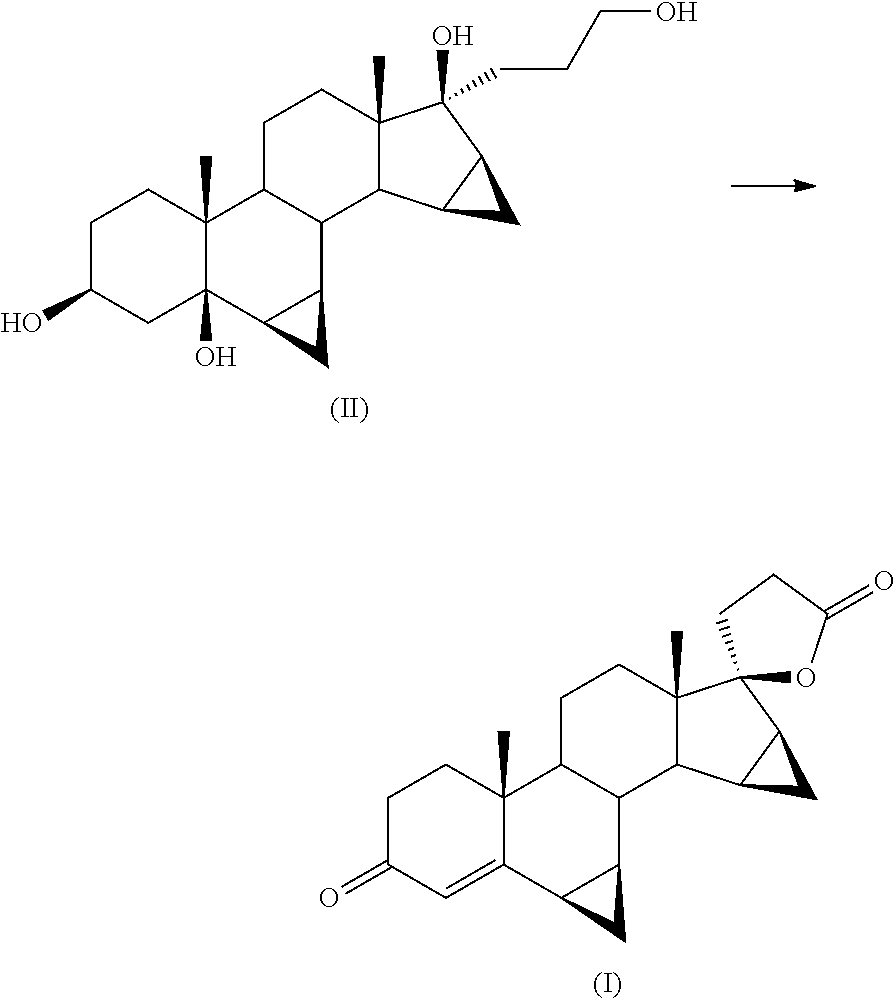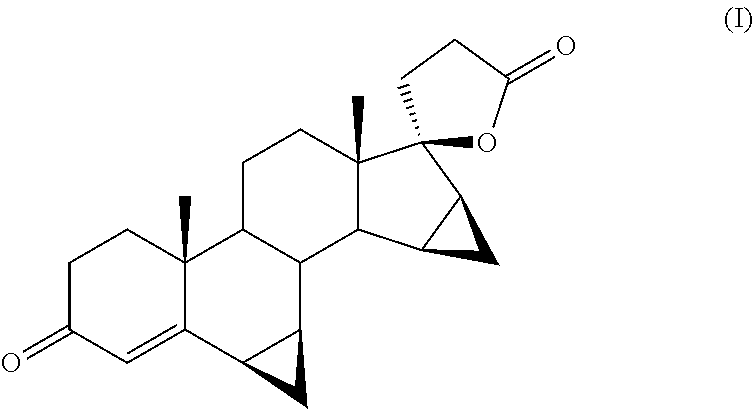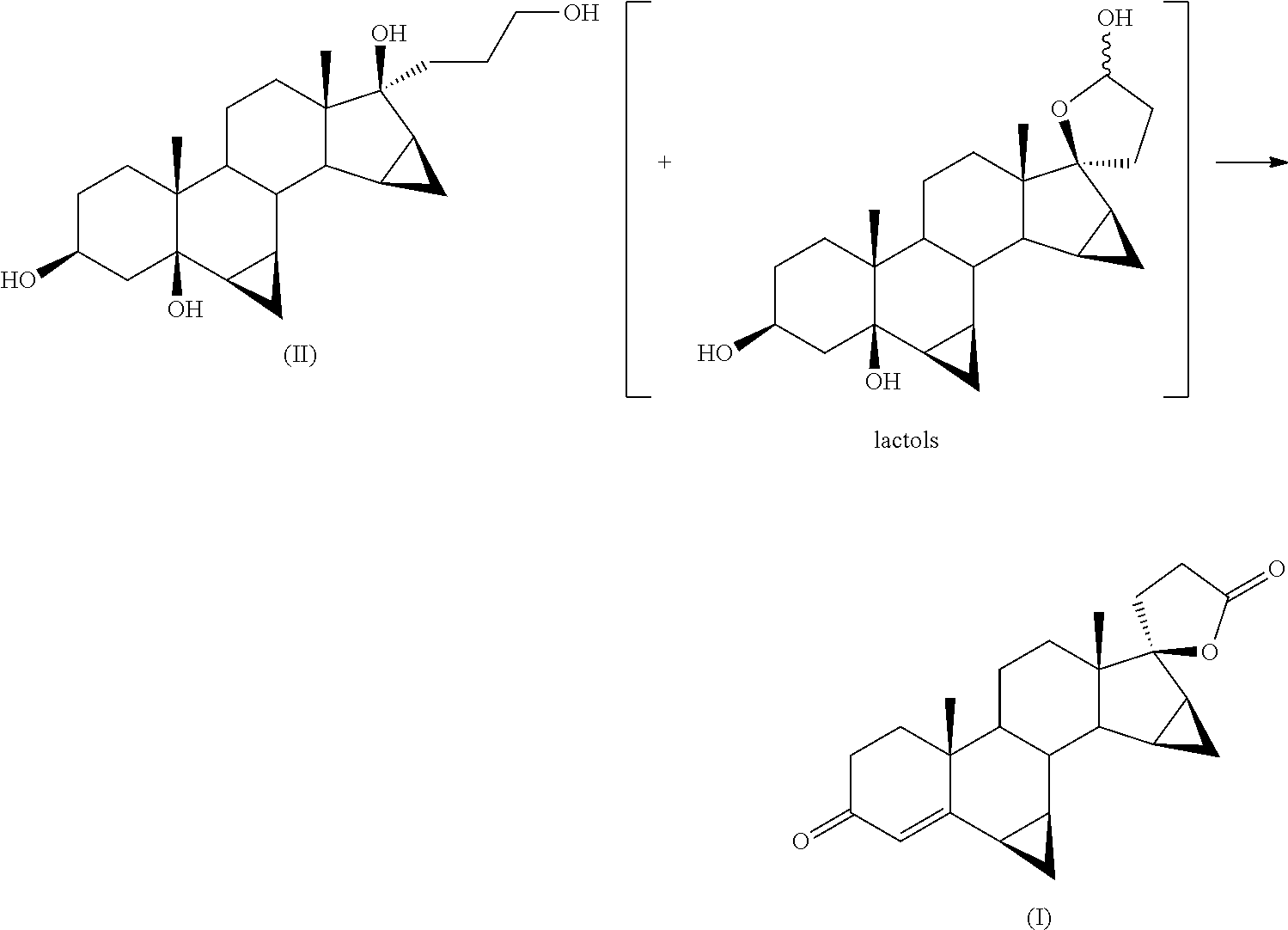Process for the Preparation of Drospirenone
- Summary
- Abstract
- Description
- Claims
- Application Information
AI Technical Summary
Benefits of technology
Problems solved by technology
Method used
Image
Examples
example 1
[0032]Into a 100 ml flask is loaded 1 g of 17α-(3-hydroxypropyl)-6β,7β;15β,16β-dimethylene-5β-androstane-3β,5,17β-triol (II) into 3 ml of glacial acetic acid. 200 mg of ferric nitrate nonahydrate, 78 mg of TEMPO and 29 mg of sodium chloride are added.
[0033]The reagent mixture is stirred at 35° C. for 16 hours in an atmosphere of pure oxygen. The progress of the reaction is monitored by TLC from which there is found the disappearance of the starting product (II) and the formation of drospirenone (I) (by comparison against samples of the pure compounds obtained by methods known in the field).
[0034]At the end of the reaction the reaction mixture is poured into 12 ml of water, it is extracted with ethyl acetate thus obtaining, after evaporation of the solvent, 1.05 g of residue.
[0035]By means of HPLC analysis (European Ph method) the previous TLC findings are confirmed: intermediate (II) absent, drospirenone (I) present. The crude product, crystallized from isopropyl acetate as per a me...
example 2
[0036]In a 100 ml flask are loaded 5 g of 17α-(3-hydroxypropyl)-6β,7β;15β,16β-dimethylene-5β-androstane-3β,5,17βp-triol (II) into 30 ml of methylene chloride. 1 g of ferric nitrate nonahydrate, 400 mg of TEMPO and 150 mg of sodium chloride and 250 mg of citric acid are added.
[0037]The reagent mixture is stirred at 35° C. for 20 hours in an atmosphere of pure oxygen. The progress of the reaction is monitored by TLC from which there is found the disappearance of the starting product (II) and the formation of drospirenone (I) (by comparison against samples of the pure compounds obtained by methods known in the field).
[0038]At the end of the reaction the reaction mixture is poured into 30 ml of water, the phases are separated and the organic phase is washed with basic solution (NaHCO3).
[0039]After evaporation of the solvent 5.2 g of raw product are obtained.
[0040]By means of HPLC analysis (European Ph method) the previous TLC findings are confirmed: intermediate (II) absent, drospirenon...
example 3
[0041]Into a 2 litre flask are loaded 23.3 g of ferric nitrate nonahydrate, 12.2 g of TEMPO, 4.5 g of sodium chloride, 750 ml of isopropyl acetate, 7.5 g of citric acid and 150 g of 170c-(3-hydroxypropyl)-6β,7β;15β,16β-dimethylene-5β-androstane-3β,5,17β-triol (II).
[0042]The mixture is stirred at 35° C. in an atmosphere of pure oxygen. The progress of the reaction is monitored after 18 hours by TLC from which there is found the disappearance of the starting product (II) and the formation of drospirenone (I) as main stain (comparison against an authentic sample).
[0043]The reaction mixture is washed with 250 ml of basic aqueous solution (NaHCO3) and then with 250 ml of water.
[0044]The solvent is eliminated under reduced pressure thus obtaining 170 g of residue. After crystallization with isopropyl acetate and dessication of the filtrate solid, there are obtained 104 g of drospirenone (I) of pharmaceutical quality.
PUM
 Login to View More
Login to View More Abstract
Description
Claims
Application Information
 Login to View More
Login to View More - R&D
- Intellectual Property
- Life Sciences
- Materials
- Tech Scout
- Unparalleled Data Quality
- Higher Quality Content
- 60% Fewer Hallucinations
Browse by: Latest US Patents, China's latest patents, Technical Efficacy Thesaurus, Application Domain, Technology Topic, Popular Technical Reports.
© 2025 PatSnap. All rights reserved.Legal|Privacy policy|Modern Slavery Act Transparency Statement|Sitemap|About US| Contact US: help@patsnap.com



